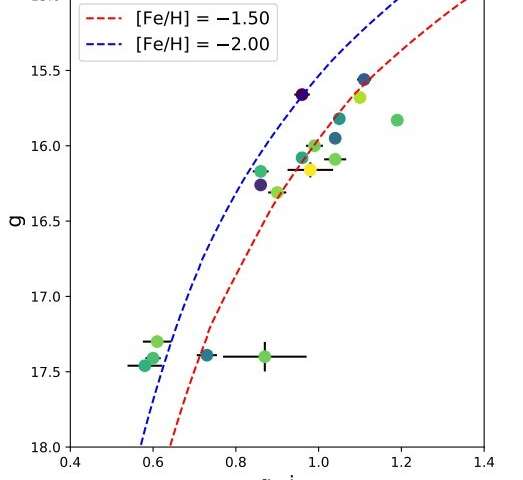#Astronomers identify 18 metal-poor stars in the Sagittarius dwarf galaxy
“#Astronomers identify 18 metal-poor stars in the Sagittarius dwarf galaxy”

Massachusetts Institute of Technology (MIT) astronomers have detected 18 very metal-poor stars in the Sagittarius dwarf galaxy. They found that one of the stars from the sample has an extremely low metallicity, slightly below -3.0. The study was reported in a paper published August 22 on the arXiv preprint repository.
Satellite dwarf spheroidal (dSph) galaxies of our Milky Way are excellent places to search and study metal-poor stars. Detailed investigation of such objects could be crucial for improving our understanding of early galactic environments. However, only a few dozen metal-poor stars (with metallicities below -2.5) in the Milky Way’s most massive dwarf satellites have been comprehensively studied and have detailed chemical abundance measurements available.
The Sagittarius Dwarf Spheroidal Galaxy (Sgr dSph for short) is the most massive among dSph of the Milky Way (with a mass of around 400 million solar masses). So far, only a handful of very metal-poor stars have been identified in Sgr dSph, mainly due to a prominent metal-rich component of the galaxy’s stellar population.
Now, a team of astronomers led by MIT’s Anirudh Chiti reports the finding of 18 metal-poor red giant stars in this galaxy. The detection is based on the medium-resolution spectra from the MagE spectrograph on the Magellan-Baade Telescope, metallicity-sensitive photometry from the SkyMapper DR1.1 catalog, and proper motion data from Gaia DR2 (Data Release 2).
“Here, we present metallicities and carbon abundances for 18 stars with metallicities between −3.08 ≤ [Fe/H] ≤−1.47 in the Sagittarius dwarf spheroidal galaxy, using medium-resolution spectra from the MagE spectrograph on the Magellan-Baade Telescope,” the astronomers wrote in the paper.
According to the study, nine stars from the sample are very metal poor, with metallicities below -2.0. This finding more than doubles the number of known very metal-poor stars in Sgr dSph. The object with the lowest metallicity (-3.08) out of the 18 described in the paper turned out to be Sgr-180. This makes Sgr-180 one of the first known extremely metal-poor stars in this galaxy.
The stars in the sample have effective temperatures ranging from 4,380 to 5,170 K, and are not carbon-enhanced. Hence, none of these objects can be classified as carbon-enhanced metal-poor (CEMP) stars. This is baffling as, for instance, the stars in the halo of our Milky Way galaxy generally exhibit an increase of relative carbon enhancement with decreasing metallicity. All in all, around 20 percent of stars in the Milky Way’s halo are classified as CEMPs with metallicity below -2.0.
In concluding remarks, the authors of the paper try to explain the observed lack of CEMP stars in Sgr dSph. The suppose that it may be due some dependence of early chemical evolution on the environment in which stars form. However, more high-resolution spectroscopic observations are required to further verify this hypothesis.
More information:
Discovery of 18 stars with −3.10 arxiv.org/abs/2008.09901
© 2020 Science X Network
Astronomers identify 18 metal-poor stars in the Sagittarius dwarf galaxy (2020, September 1)
retrieved 1 September 2020
from https://phys.org/news/2020-09-astronomers-metal-poor-stars-sagittarius-dwarf.html
This document is subject to copyright. Apart from any fair dealing for the purpose of private study or research, no
part may be reproduced without the written permission. The content is provided for information purposes only.
If you want to read more Like this articles, you can visit our Science category.
if you want to watch Movies or Tv Shows go to Dizi.BuradaBiliyorum.Com for forums sites go to Forum.BuradaBiliyorum.Com



